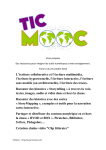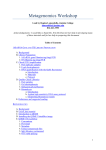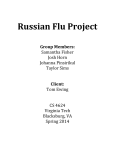Download SortMeRNA User Manual
Transcript
SortMeRNA User Manual Evguenia Kopylova [email protected] Oct 2014, version 2.0 1 Contents 1 Introduction 2 Installation 2.1 Install from tarball release . . . . . . 2.2 Install development version from git 2.3 Install from precompiled code . . . . 2.4 Uninstall . . . . . . . . . . . . . . . 3 . . . . . . . . . . . . . . . . . . . . . . . . . . . . . . . . . . . . . . . . . . . . . . . . . . . . . . . . . . . . . . . . . . . . . . . . . . . . . . . . . . . . . . . . . . . . . . . . . . . . . . . . . . . . 3 Databases 3 3 4 4 5 5 4 How to run SortMeRNA 4.1 Index the rRNA database: command ‘indexdb rna’ . . . . . . . . . . . . . . . . . . 4.1.1 Example 1: indexdb rna using one database . . . . . . . . . . . . . . . . . . . 4.1.2 Example 2: indexdb rna using multiple databases . . . . . . . . . . . . . . . . 4.2 A guide to choosing ‘sortmerna’ parameters for filtering and read mapping . . . . . 4.3 Filter rRNA reads . . . . . . . . . . . . . . . . . . . . . . . . . . . . . . . . . . . . . 4.3.1 Example 3: multiple databases and the fastest alignment option . . . . . . . 4.3.2 Filtering paired-end reads . . . . . . . . . . . . . . . . . . . . . . . . . . . . . 4.3.3 Example 4: forward-reverse paired-end reads (2 input files) . . . . . . . . . . 4.4 Read mapping . . . . . . . . . . . . . . . . . . . . . . . . . . . . . . . . . . . . . . . 4.4.1 Mapping reads for classification . . . . . . . . . . . . . . . . . . . . . . . . . . 4.4.2 Example 5: mapping reads against the 16S Greengenes 97% id database with multithreading . . . . . . . . . . . . . . . . . . . . . . . . . . . . . . . . . . . 4.5 OTU-picking . . . . . . . . . . . . . . . . . . . . . . . . . . . . . . . . . . . . . . . . 17 19 5 SortMeRNA advanced options 19 6 Help 20 7 Citation 20 2 5 5 6 7 8 9 11 14 15 17 17 1 Introduction Copyright (C) 2012-2015 Bonsai Bioinformatics Research Group (LIFL - Universit´e Lille 1), CNRS UMR 8022, INRIA Nord-Europe http://bioinfo.lifl.fr/RNA/sortmerna/ OTU-picking extensions and continuous support developed in the Knight Lab, BioFrontiers Institute, University of Colorado at Boulder, CO https://knightlab.colorado.edu SortMeRNA is a local sequence alignment tool for filtering, mapping and OTU-picking. The core algorithm is based on approximate seeds and allows for fast and sensitive analyses of NGS reads. The main application of SortMeRNA is filtering rRNA from metatranscriptomic data. Additional applications include OTU-picking and taxonomy assignation available through QIIME v1.9+ (http://qiime.org, currently the development version to be released in early December). SortMeRNA takes as input a file of reads (fasta or fastq format) and one or multiple rRNA database file(s), and sorts apart aligned and rejected reads into two files specified by the user. SortMeRNA works with Illumina, 454, Ion Torrent and PacBio data, and can produce SAM and BLAST-like alignments. For questions & help, please contact: 1. Evguenia Kopylova 2. Laurent Noe 3. Helene Touzet [email protected] [email protected] [email protected] Important: This user manual is strictly for SortMeRNA version 2.0. 2 Installation 2.1 Install from tarball release 1. Download sortmerna-2.0.tar.gz from https://github.com/biocore/sortmerna/releases 2. Extract the source code package into a directory of your choice, enter sortmerna-2.0 directory and type, > bash ./build.sh 3. At this point, two executables indexdb rna and sortmerna will be located in the sortmerna-2.0 directory. If the user would like to install the executables into their default installation directory (/usr/local/bin for Linux or /opt/local/bin for Mac) then type, > make install (with root permissions) 4. To begin using SortMeRNA, type ‘indexdb rna -h’ or ‘sortmerna -h’. Databases must first be indexed using indexdb rna. 3 Figure 1: sortmerna-2.0 directory tree sortmerna-2.0 alp cmph src include scripts tests rRNA databases silva-bac-16s-id90.fasta ... sortmerna indexdb rna 2.2 Install development version from git 1. Clone the sortmerna directory to your local system > git clone https://github.com/biocore/sortmerna.git 2. Build sortmerna > cd sortmerna > bash ./build.sh 2.3 Install from precompiled code 1. Download the latest binary distribution of SortMeRNA from http://bioinfo.lifl.fr/RNA/ sortmerna 2. Extract the source code package into a directory of your choice, > tar -xvf sortmerna-2.0.tar.gz > cd sortmerna-2.0 3. To begin using SortMeRNA, type ‘indexdb rna -h’ or ‘sortmerna -h’. The user must firstly index the databases with the command indexdb rna before they can run the command sortmerna. 4 2.4 Uninstall If the user installed SortMeRNA using the command ‘make install’, then they can use the command ‘make uninstall’ to uninstall SortMeRNA (with root permissions). 3 Databases SortMeRNA comes prepackaged with 8 databases, representative database silva-bac-16s-id90 silva-arc-16s-id95 silva-euk-18s-id95 silva-bac-23s-id98 silva-arc-23s-id98 silva-euk-28s-id98 rfam-5s-id98 rfam-5.8s-id98 %id 90 95 95 98 98 98 98 98 # seq (clustered) 12798 3193 7348 4488 251 4935 59513 13034 origin SILVA SSU Ref NR v.119 SILVA SSU Ref NR v.119 SILVA SSU Ref NR v.119 SILVA LSU Ref v.119 SILVA LSU Ref v.119 SILVA LSU Ref v.119 RFAM RFAM # seq (original) 464618 18797 51553 43822 629 13095 116760 225185 HMMER 3.1b1 and SumaClust v1.0.00 were used to reduce the size of the original databases to the similarity listed in column 2 (%id) of the table above (see /sortmerna/rRNA databases/README.txt for a list of complete steps). These representative databases were specifically made for fast filtering of rRNA. Approximately the same number of rRNA will be filtered using silva-bac-16s-id90 (12802 rRNA) as using Greengenes 97% (99322 rRNA), but the former will run significantly faster. id %: members of the cluster must have identity at least this % id with the representative sequence Remark: The user must first index the fasta database by using the command indexdb rna and then filter/map reads against the database using the command sortmerna. 4 How to run SortMeRNA 4.1 Index the rRNA database: command ‘indexdb rna’ The executable indexdb rna indexes an rRNA database. To see the man page for indexdb rna, >> indexdb_rna -h Program: Copyright: SortMeRNA version 2.0, 29/11/2014 2012-2015 Bonsai Bioinformatics Research Group: LIFL, University Lille 1, CNRS UMR 8022, INRIA Nord-Europe OTU-picking extensions and continuing support developed in the Knight Lab, BioFrontiers Institute, University of Colorado at Boulder 5 Disclaimer: Contact: usage: SortMeRNA comes with ABSOLUTELY NO WARRANTY; without even the implied warranty of MERCHANTABILITY or FITNESS FOR A PARTICULAR PURPOSE. See the GNU Lesser General Public License for more details. Evguenia Kopylova, [email protected] Laurent Noe, [email protected] Helene Touzet, [email protected] ./indexdb_rna --ref db.fasta,db.idx [OPTIONS]: -------------------------------------------------------------------------------------------------------| parameter value description default | ---------------------------------------------------------------------------------------------------------ref STRING,STRING FASTA reference file, index file mandatory (ex. --ref /path/to/file1.fasta,/path/to/index1) If passing multiple reference sequence files, separate them by ’:’, (ex. --ref /path/to/file1.fasta,/path/to/index1:/path/to/file2.fasta,path/to/index2) [OPTIONS]: --fast BOOL suggested option for aligning ~99% related species off --sensitive BOOL suggested option for aligning ~75-98% related species on --tmpdir STRING directory where to write temporary files -m INT the amount of memory (in Mbytes) for building the index 3072 -L INT seed length 18 --max_pos INT maximum number of positions to store for each unique L-mer 10000 (setting --max_pos 0 will store all positions) -v BOOL verbose -h BOOL help There are eight rRNA representative databases provided in the ‘sortmerna-2.0/rRNA databases’ folder. All databases were derived from the SILVA SSU and LSU databases (release 119) and the RFAM databases using HMMER 3.1b1 and SumaClust v1.0.00. Additionally, the user can index their own database. 4.1.1 Example 1: indexdb rna using one database >> ./indexdb_rna --ref ./rRNA_databases/silva-bac-16s-id90.fasta,./index/silva-bac-16s-db -v Program: Copyright: Disclaimer: Contact: SortMeRNA version 2.0, 29/11/2014 2012-2015 Bonsai Bioinformatics Research Group: LIFL, University Lille 1, CNRS UMR 8022, INRIA Nord-Europe OTU-picking extensions and continuing support developed in the Knight Lab, BioFrontiers Institute, University of Colorado at Boulder SortMeRNA comes with ABSOLUTELY NO WARRANTY; without even the implied warranty of MERCHANTABILITY or FITNESS FOR A PARTICULAR PURPOSE. See the GNU Lesser General Public License for more details. Evguenia Kopylova, [email protected] Laurent Noe, [email protected] Helene Touzet, [email protected] Parameters summary: K-mer size: 19 K-mer interval: 1 Maximum positions to store per unique K-mer: 10000 6 Total number of databases to index: 1 Begin indexing file ./rRNA_databases/silva-bac-16s-id90.fasta under index name ./index/silva-bac-16s-db: Collecting sequence distribution statistics .. done [1.133206 sec] start index part # 0: (1/3) building burst tries .. done [23.643256 sec] (2/3) building CMPH hash .. done [22.306709 sec] (3/3) building position lookup tables .. done [54.958680 sec] total number of sequences in this part = 12798 writing kmer data to ./index/silva-bac-16s-db.kmer_0.dat writing burst tries to ./index/silva-bac-16s-db.bursttrie_0.dat writing position lookup table to ./index/silva-bac-16s-db.pos_0.dat writing nucleotide distribution statistics to ./index/silva-bac-16s-db.stats done. 4.1.2 Example 2: indexdb rna using multiple databases Multiple databases can be indexed simultaneously by passing them as a ‘:’ separated list to --ref (no spaces allowed). >> ./indexdb_rna --ref ./rRNA_databases/silva-bac-16s-id90.fasta,./index/silva-bac-16s-db:\ ./rRNA_databases/silva-bac-23s-id98.fasta,./index/silva-bac-23s-db:\ ./rRNA_databases/silva-arc-16s-id95.fasta,./index/silva-arc-16s-db:\ ./rRNA_databases/silva-arc-23s-id98.fasta,./index/silva-arc-23s-db:\ ./rRNA_databases/silva-euk-18s-id95.fasta,./index/silva-euk-18s-db:\ ./rRNA_databases/silva-euk-28s-id98.fasta,./index/silva-euk-28s:\ ./rRNA_databases/rfam-5s-database-id98.fasta,./index/rfam-5s-db:\ ./rRNA_databases/rfam-5.8s-database-id98.fasta,./index/rfam-5.8s-db 7 4.2 A guide to choosing ‘sortmerna’ parameters for filtering and read mapping In SortMeRNA version 1.99 beta and up, users have the option to output sequence alignments for their matching rRNA reads in the SAM or BLAST-like formats. Depending on the desired quality of alignments, different parameters choices must be set. Table 1 presents a guide to setting parameters choices for most use cases. In all cases, output alignments are always guaranteed to reach the threshold E-value score (default E-value=1). An E-value of 1 signifies that one random alignment is expected for aligning all reads against the reference database. The E-value in SortMeRNA is computed for the entire search space, not per read. Table 1: SortMeRNA alignment parameter guide option speed description Very fast for INT = 1 Output the first alignment passing E-value threshold (best choice if only filtering is needed) Speed decreases for higher value INT --num-alignments INT Very slow for INT = 0 Fast for INT = 1 --best INT Speed decreases for higher value INT Very slow for INT = 0 8 Higher INT signifies more alignments will be made & output All alignments reaching the E-value threshold are reported (this option is not suggested for high similarity rRNA databases, due to many possible alignments per read causing a very large file output) Only one high-candidate reference sequence will be searched for alignments (determined heuristically using a Longest Increasing Subsequence of seed matches). The single best alignment of those will be reported Higher INT signifies more alignments will be made, though only the best one will be reported All high-candidate reference sequences will be searched for alignments, though only the best one will be reported 4.3 Filter rRNA reads The executable sortmerna can filter rRNA reads against an indexed rRNA database. To see the man page for sortmerna, >> ./sortmerna -h Program: Copyright: Disclaimer: Contact: usage: SortMeRNA version 2.0, 29/11/2014 2012-2015 Bonsai Bioinformatics Research Group: LIFL, University Lille 1, CNRS UMR 8022, INRIA Nord-Europe OTU-picking extensions and continuing support developed in the Knight Lab, BioFrontiers Institute, University of Colorado at Boulder SortMeRNA comes with ABSOLUTELY NO WARRANTY; without even the implied warranty of MERCHANTABILITY or FITNESS FOR A PARTICULAR PURPOSE. See the GNU Lesser General Public License for more details. Evguenia Kopylova, [email protected] Laurent Noe, [email protected] Helene Touzet, [email protected] ./sortmerna --ref db.fasta,db.idx --reads file.fa --aligned base_name_output [OPTIONS]: ------------------------------------------------------------------------------------------------------------| parameter value description default | --------------------------------------------------------------------------------------------------------------ref STRING,STRING FASTA reference file, index file mandatory (ex. --ref /path/to/file1.fasta,/path/to/index1) If passing multiple reference files, separate them using the delimiter ’:’, (ex. --ref /path/to/file1.fasta,/path/to/index1:/path/to/file2.fasta,path/to/index2 --reads STRING FASTA/FASTQ reads file mandatory --aligned STRING aligned reads filepath + base file name mandatory (appropriate extension will be added) [COMMON OPTIONS]: --other STRING --fastx BOOL --sam BOOL --SQ --blast BOOL INT --log --num_alignments BOOL INT or (default) --best INT --min_lis INT --print_all_reads BOOL rejected reads filepath + base file name (appropriate extension will be added) output FASTA/FASTQ file (for aligned and/or rejected reads) output SAM alignment (for aligned reads only) add SQ tags to the SAM file output alignments in various Blast-like formats 0 - pairwise 1 - tabular (Blast -m 8 format) 2 - tabular + column for CIGAR 3 - tabular + columns for CIGAR and query coverage output overall statistics report first INT alignments per read reaching E-value (--num_alignments 0 signifies all alignments will be output) off off off off -1 report INT best alignments per read reaching E-value 1 by searching --min_lis INT candidate alignments (--best 0 signifies all candidate alignments will be searched) search all alignments having the first INT longest LIS 2 LIS stands for Longest Increasing Subsequence, it is computed using seeds’ positions to expand hits into longer matches prior to Smith-Waterman alignment. output null alignment strings for non-aligned reads off to SAM and/or BLAST tabular files 9 --paired_in BOOL --paired_out BOOL --match --mismatch --gap_open --gap_ext -N -F -R -a -e -m INT INT INT INT INT BOOL BOOL INT DOUBLE INT -v BOOL [OTU PICKING OPTIONS]: --id DOUBLE --coverage DOUBLE --de_novo_otu BOOL --otu_map BOOL both paired-end reads go in --aligned fasta/q file (interleaved reads only, see Section 4.2.4 of User Manual) both paired-end reads go in --other fasta/q file (interleaved reads only, see Section 4.2.4 of User Manual) SW score (positive integer) for a match SW penalty (negative integer) for a mismatch SW penalty (positive integer) for introducing a gap SW penalty (positive integer) for extending a gap SW penalty for ambiguous letters (N’s) search only the forward strand search only the reverse-complementary strand number of threads to use E-value threshold INT Mbytes for loading the reads into memory (maximum -m INT is 4096) verbose %id similarity threshold (the alignment must still pass the E-value threshold) %query coverage threshold (the alignment must still pass the E-value threshold) FASTA/FASTQ file for reads matching database < %id (set using --id) and < %cov (set using --coverage) (alignment must still pass the E-value threshold) output OTU map (input to QIIME’s make_otu_table.py) [ADVANCED OPTIONS] (see SortMeRNA user manual for more details): --passes INT,INT,INT three intervals at which to place the seed on the read (L is the seed length set in ./indexdb_rna) --edges INT number (or percent if INT followed by % sign) of nucleotides to add to each edge of the read prior to SW local alignment --num_seeds INT number of seeds matched before searching for candidate LIS --full_search BOOL search for all 0-error and 1-error seed matches in the index rather than stopping after finding a 0-error match (<1% gain in sensitivity with up four-fold decrease in speed) --pid BOOL add pid to output file names [HELP]: -h --version BOOL BOOL help SortMeRNA version number The user can adjust the amount of memory allocated for loading the reads through the command option -m. By default, -m is set to be high enough for 1GB. If the reads file is larger than 1GB, then sortmerna internally divides the file into partial sections of 1GB and executes one section at a time. Hence, if a user has an input file of 15GB and only 1GB of RAM to store it, the file will be processed in partial sections using mmap without having to physically split it prior to execution. Otherwise, the user can increase -m to map larger portions of the file. The limit for -m is given by typing sortmerna -h. 10 off off 2 -3 5 2 scored as --mismatch off off 1 1 1024 off 0.97 0.97 off off L,L/2,3 4 2 off off 4.3.1 Example 3: multiple databases and the fastest alignment option >> time ./sortmerna --ref ./rRNA_databases/silva-bac-16s-id90.fasta,./index/silva-bac-16s-db:\ ./rRNA_databases/silva-bac-23s-id98.fasta,./index/silva-bac-23s-db:\ ./rRNA_databases/silva-arc-16s-id95.fasta,./index/silva-arc-16s-db:\ ./rRNA_databases/silva-arc-23s-id98.fasta,./index/silva-arc-23s-db:\ ./rRNA_databases/silva-euk-18s-id95.fasta,./index/silva-euk-18s-db:\ ./rRNA_databases/silva-euk-28s-id98.fasta,./index/silva-euk-28s:\ ./rRNA_databases/rfam-5s-database-id98.fasta,./index/rfam-5s-db:\ ./rRNA_databases/rfam-5.8s-database-id98.fasta,./index/rfam-5.8s-db\ --reads SRR106861.fasta --sam --num_alignments 1 --fastx --aligned SRR105861_rRNA\ --other SRR105861_non_rRNA --log -v Program: Copyright: Disclaimer: Contact: SortMeRNA version 2.0, 29/11/2014 2012-2015 Bonsai Bioinformatics Research Group: LIFL, University Lille 1, CNRS UMR 8022, INRIA Nord-Europe OTU-picking extensions and continuing support developed in the Knight Lab, BioFrontiers Institute, University of Colorado at Boulder SortMeRNA comes with ABSOLUTELY NO WARRANTY; without even the implied warranty of MERCHANTABILITY or FITNESS FOR A PARTICULAR PURPOSE. See the GNU Lesser General Public License for more details. Evguenia Kopylova, [email protected] Laurent Noe, [email protected] Helene Touzet, [email protected] Computing read file statistics ... done [2.16 sec] size of reads file: 35238748 bytes partial section(s) to be executed: 1 of size 35238748 bytes Parameters summary: Number of seeds = 2 Edges = 4 (as integer) SW match = 2 SW mismatch = -3 SW gap open penalty = 5 SW gap extend penalty = 2 SW ambiguous nucleotide = -3 SQ tags are not output Number of threads = 1 Begin mmap reads section # 1: Time to mmap reads and set up pointers [0.11 sec] Begin analysis of: ./rRNA_databases/silva-bac-16s-id90.fasta Seed length = 18 Pass 1 = 18, Pass 2 = 9, Pass 3 = 3 Gumbel lambda = 0.602397 Gumbel K = 0.328927 Minimal SW score based on E-value = 54 Loading index part 1/1 ... done [4.67 sec] Begin index search ... done [83.53 sec] Freeing index ... done [0.87 sec] Begin analysis of: ./rRNA_databases/silva-bac-23s-id98.fasta Seed length = 18 Pass 1 = 18, Pass 2 = 9, Pass 3 = 3 Gumbel lambda = 0.603075 Gumbel K = 0.330488 Minimal SW score based on E-value = 53 Loading index part 1/1 ... done [3.63 sec] Begin index search ... done [94.76 sec] 11 Freeing index ... done [0.41 sec] Begin analysis of: ./rRNA_databases/silva-arc-16s-id95.fasta Seed length = 18 Pass 1 = 18, Pass 2 = 9, Pass 3 = 3 Gumbel lambda = 0.596230 Gumbel K = 0.322143 Minimal SW score based on E-value = 52 Loading index part 1/1 ... done [1.14 sec] Begin index search ... done [22.63 sec] Freeing index ... done [0.14 sec] Begin analysis of: ./rRNA_databases/silva-arc-23s-id98.fasta Seed length = 18 Pass 1 = 18, Pass 2 = 9, Pass 3 = 3 Gumbel lambda = 0.597749 Gumbel K = 0.325630 Minimal SW score based on E-value = 49 Loading index part 1/1 ... done [0.50 sec] Begin index search ... done [13.27 sec] Freeing index ... done [0.06 sec] Begin analysis of: ./rRNA_databases/silva-euk-18s-id95.fasta Seed length = 18 Pass 1 = 18, Pass 2 = 9, Pass 3 = 3 Gumbel lambda = 0.612228 Gumbel K = 0.334926 Minimal SW score based on E-value = 52 Loading index part 1/1 ... done [3.23 sec] Begin index search ... done [30.28 sec] Freeing index ... done [0.45 sec] Begin analysis of: ./rRNA_databases/silva-euk-28s-id98.fasta Seed length = 18 Pass 1 = 18, Pass 2 = 9, Pass 3 = 3 Gumbel lambda = 0.612068 Gumbel K = 0.344763 Minimal SW score based on E-value = 53 Loading index part 1/1 ... done [3.43 sec] Begin index search ... done [35.69 sec] Freeing index ... done [0.48 sec] Begin analysis of: ./rRNA_databases/rfam-5s-database-id98.fasta Seed length = 18 Pass 1 = 18, Pass 2 = 9, Pass 3 = 3 Gumbel lambda = 0.616617 Gumbel K = 0.341306 Minimal SW score based on E-value = 51 Loading index part 1/1 ... done [1.77 sec] Begin index search ... done [13.50 sec] Freeing index ... done [0.22 sec] Begin analysis of: ./rRNA_databases/rfam-5.8s-database-id98.fasta Seed length = 18 Pass 1 = 18, Pass 2 = 9, Pass 3 = 3 Gumbel lambda = 0.617817 Gumbel K = 0.340589 Minimal SW score based on E-value = 49 Loading index part 1/1 ... done [0.60 sec] Begin index search ... done [8.78 sec] Freeing index ... done [0.07 sec] Total number of reads mapped (incl. all reads file sections searched): 104243 12 Writing aligned FASTA/FASTQ ... done [1.13 sec] Writing not-aligned FASTA/FASTQ ... done [0.10 sec] The option ‘--log’ will create an overall statistics file, >> cat SRR105861_rRNA.log Time and date Command: sortmerna --ref ./rRNA_databases/silva-bac-16s-id90.fasta,./index/silva-bac-16s-db:\ ./rRNA_databases/silva-bac-23s-id98.fasta,./index/silva-bac-23s-db:\ ./rRNA_databases/silva-arc-16s-id95.fasta,./index/silva-arc-16s-db:\ ./rRNA_databases/silva-arc-23s-id98.fasta,./index/silva-arc-23s-db:\ ./rRNA_databases/silva-euk-18s-id95.fasta,./index/silva-euk-18s-db:\ ./rRNA_databases/silva-euk-28s-id98.fasta,./index/silva-euk-28s:\ ./rRNA_databases/rfam-5s-database-id98.fasta,./index/rfam-5s-db:\ ./rRNA_databases/rfam-5.8s-database-id98.fasta,./index/rfam-5.8s-db\ --reads /Users/jenya/Downloads/SRR106861.fasta --sam --num_alignments 1\ --fastx --aligned SRR105861_rRNA --other SRR105861_non_rRNA.fasta fasta -v Process pid = 1957 Parameters summary: Index: ./index/silva-bac-16s-db Seed length = 18 Pass 1 = 18, Pass 2 = 9, Pass 3 = 3 Gumbel lambda = 0.602397 Gumbel K = 0.328927 Minimal SW score based on E-value = 54 Index: ./index/silva-bac-23s-db Seed length = 18 Pass 1 = 18, Pass 2 = 9, Pass 3 = 3 Gumbel lambda = 0.603075 Gumbel K = 0.330488 Minimal SW score based on E-value = 53 Index: ./index/silva-arc-16s-db Seed length = 18 Pass 1 = 18, Pass 2 = 9, Pass 3 = 3 Gumbel lambda = 0.596230 Gumbel K = 0.322143 Minimal SW score based on E-value = 52 Index: ./index/silva-arc-23s-db Seed length = 18 Pass 1 = 18, Pass 2 = 9, Pass 3 = 3 Gumbel lambda = 0.597749 Gumbel K = 0.325630 Minimal SW score based on E-value = 49 Index: ./index/silva-euk-18s-db Seed length = 18 Pass 1 = 18, Pass 2 = 9, Pass 3 = 3 Gumbel lambda = 0.612228 Gumbel K = 0.334926 Minimal SW score based on E-value = 52 Index: ./index/silva-euk-28s Seed length = 18 Pass 1 = 18, Pass 2 = 9, Pass 3 = 3 Gumbel lambda = 0.612068 Gumbel K = 0.344763 Minimal SW score based on E-value = 53 Index: ./index/rfam-5s-db Seed length = 18 Pass 1 = 18, Pass 2 = 9, Pass 3 = 3 13 Gumbel lambda = 0.616617 Gumbel K = 0.341306 Minimal SW score based on E-value = 51 Index: ./index/rfam-5.8s-db Seed length = 18 Pass 1 = 18, Pass 2 = 9, Pass 3 = 3 Gumbel lambda = 0.617817 Gumbel K = 0.340589 Minimal SW score based on E-value = 49 Number of seeds = 2 Edges = 4 (as integer) SW match = 2 SW mismatch = -3 SW gap open penalty = 5 SW gap extend penalty = 2 SW ambiguous nucleotide = -3 SQ tags are not output Number of threads = 1 Reads file = SRR106861.fasta Results: Total reads = 113128 Total reads passing E-value threshold = 104243 (92.15%) Total reads failing E-value threshold = 8885 (7.85%) Minimum read length = 59 Maximum read length = 1253 Mean read length = 267 By database: ./rRNA_databases/silva-bac-16s-id90.fasta ./rRNA_databases/silva-bac-23s-id98.fasta ./rRNA_databases/silva-arc-16s-id95.fasta ./rRNA_databases/silva-arc-23s-id98.fasta ./rRNA_databases/silva-euk-18s-id95.fasta ./rRNA_databases/silva-euk-28s-id98.fasta ./rRNA_databases/rfam-5s-database-id98.fasta ./rRNA_databases/rfam-5.8s-database-id98.fasta 4.3.2 25.73% 64.37% 0.00% 0.00% 0.00% 0.00% 2.04% 0.00% Filtering paired-end reads When writing aligned and non-aligned reads to FASTA/Q files, sometimes the situation arises where one of the paired-end reads aligns and the other one doesn’t. Since SortMeRNA looks at each read individually, by default the reads will be split into two separate files. That is, the read that aligned will go into the --aligned FASTA/Q file and the pair that didn’t align will go into the --other FASTA/Q file. This situation would result in the splitting of some paired reads in the output files and not optimal for users who require paired order of the reads for downstream analyses. For users who wish to keep the order of their paired-ended reads, two options are available. If one read aligns and the other one not then, (1) --paired-in will put both reads into the file specified by --aligned (2) --paired-out will put both reads into the file specified by --other The first option, --paired-in is optimal for users that want all reads in the --other file to be non-rRNA. However, there are small chances that reads which are non-rRNA will also be put into the --aligned file. 14 The second option, --paired-out is optimal for users that want only rRNA reads in the --aligned file. However, there are small chances that reads which are rRNA will also be put into the --other file. If neither of these two options is added to the sortmerna command, then aligned and non-aligned reads will be properly output to the --aligned and --other files, possibly breaking the order for a set of paired reads between two output files. It’s important to note that regardless of the options used, the --log file will always report the true number of reads classified as rRNA (not the number of reads in the --aligned file). 4.3.3 Example 4: forward-reverse paired-end reads (2 input files) FASTQ forward reads @SEQUENCE ID 1/1 ACTT.. + QUALITY 1/1 @SEQUENCE ID 2/1 GTTA.. + QUALITY 2/1 FASTQ reverse reads pair # 1 pair # 2 .. @SEQUENCE ID 1/2 GTAC.. + QUALITY 1/2 @SEQUENCE ID 2/2 CCAC.. + QUALITY 2/2 .. Figure 2: Forward and reverse reads in paired-end sequencing format FASTQ paired-end reads @SEQUENCE ID 1/1 ACTT.. + QUALITY 1/1 @SEQUENCE ID 1/2 GTAC.. + QUALITY 1/2 .. pair # 1 Figure 3: Paired-end read format accepted by SortMeRNA SortMeRNA accepts only 1 file as input for the reads. If a user has two input files, in the case for the foward and reverse paired-end reads (see Figure 2), they may use the merge-paired-reads.sh script found in ‘sortmerna/scripts’ folder to interleave the paired reads into the format of Figure 3. The command for merge-paired-reads.sh is the following, > bash ./merge-paired-reads.sh forward-reads.fastq reverse-reads.fastq outfile.fastq 15 Now, the user may input outfile.fastq to SortMeRNA for analysis. Similarly, for unmerging the paired reads back into two separate files, use the command, > bash ./unmerge-paired-reads.sh merged-reads.fastq forward-reads.fastq reverse-reads.fastq Important: unmerge-paired-reads.sh should only be used if one of the options --paired in or --paired out was used during filtering. Otherwise it may give incorrect results if a paired-read was split during alignment (one read aligned and the other one not). 16 4.4 4.4.1 Read mapping Mapping reads for classification Although SortMeRNA is very sensitive with the small rRNA databases distributed with the source code, these databases are not optimal for classification since often alignments with 75-90% identity will be returned (there are only several thousand rRNA in most of the databases, compared to the original SILVA or Greengenes databases containing millions of rRNA). Classification at the species level generally considers alignments at 97% and above, so it is suggested to use a larger database is species classification is the main goal. Moreover, SortMeRNA is a local alignment tool, so it’s also important to look at the query coverage % for each alignment. In the SAM output format, neither % id or query coverage are reported. If the user wishes for these values, then the Blast tabular format with CIGAR + query coverage option (--blast 3) is the way to go. 4.4.2 Example 5: mapping reads against the 16S Greengenes 97% id database with multithreading This example will generate SAM and BLAST tabular output files. Alignments are classified as significant based on the E-value cutoff (default 1). SortMeRNA’s E-value takes into consideration the full size of the reference database as well as the query file, thus the E-value is higher than BLAST’s (ex. equivalent to BLAST’s 1e-5). >> sortmerna --ref 97_otus_gg_13_8.fasta,./index/97_otus_gg_13_8\ --reads SRR106861.fasta --blast 3 --sam --log --aligned SRR106861_gg_rRNA -a 20 -v Program: Copyright: Disclaimer: Contact: SortMeRNA version 2.0, 29/11/2014 2012-2015 Bonsai Bioinformatics Research Group: LIFL, University Lille 1, CNRS UMR 8022, INRIA Nord-Europe OTU-picking extensions and continuing support developed in the Knight Lab, BioFrontiers Institute, University of Colorado at Boulder SortMeRNA comes with ABSOLUTELY NO WARRANTY; without even the implied warranty of MERCHANTABILITY or FITNESS FOR A PARTICULAR PURPOSE. See the GNU Lesser General Public License for more details. Evguenia Kopylova, [email protected] Laurent Noe, [email protected] Helene Touzet, [email protected] Computing read file statistics ... done [0.44 sec] size of reads file: 35238748 bytes partial section(s) to be executed: 1 of size 35238748 bytes Parameters summary: Number of seeds = 2 Edges = 4 (as integer) SW match = 2 SW mismatch = -3 SW gap open penalty = 5 SW gap extend penalty = 2 SW ambiguous nucleotide = -3 SQ tags are not output Number of threads = 20 Begin mmap reads section # 1: Time to mmap reads and set up pointers [0.10 sec] 17 Begin analysis of: 97_otus_gg_13_8.fasta Seed length = 18 Pass 1 = 18, Pass 2 = 9, Pass 3 = 3 Gumbel lambda = 0.600470 Gumbel K = 0.327880 Minimal SW score based on E-value = 57 Loading index part 1/1 ... done [10.76 sec] Begin index search ... done [23.75 sec] Freeing index ... done [1.44 sec] Total number of reads mapped (incl. all reads file sections searched): 29089 Writing alignments ... done [7.71 sec] This is almost the same number of 16S rRNA as identified by SortMeRNA using the smaller provided database, >> cat SRR106861_gg_rRNA.log Date and time Command: sortmerna --ref 97_otus_gg_13_8.fasta,./index/97_otus_gg_13_8\ --reads SRR106861.fasta --blast 3 --sam --log --aligned SRR106861_gg_rRNA -a 20 -v Process pid = 44246 Parameters summary: Index: ./index/97_otus_gg_13_8 Seed length = 18 Pass 1 = 18, Pass 2 = 9, Pass 3 = 3 Gumbel lambda = 0.600470 Gumbel K = 0.327880 Minimal SW score based on E-value = 57 Number of seeds = 2 Edges = 4 (as integer) SW match = 2 SW mismatch = -3 SW gap open penalty = 5 SW gap extend penalty = 2 SW ambiguous nucleotide = -3 SQ tags are not output Number of threads = 20 Reads file = SRR106861.fasta Results: Total reads = 113128 Total reads passing E-value threshold = 29089 (25.71%) Total reads failing E-value threshold = 84039 (74.29%) Minimum read length = 59 Maximum read length = 1253 Mean read length = 267 By database: 97_otus_gg_13_8.fasta 25.71% 18 4.5 OTU-picking SortMeRNA is implemented in QIIME’s closed-reference and open-reference OTU-picking workflows. The readers are referred to QIIME’s tutorials for an in-depth discussion of these methods http://qiime.org/tutorials/otu_picking.html. 5 SortMeRNA advanced options --num seeds INT The threshold number of seeds required to match in the primary seed-search filter before moving on to the secondary seed-cluster filter. More specifically, the threshold number of seeds required before searching for a longest increasing subsequence (LIS) of the seeds’ positions between the read and the closest matching reference sequence. By default, this is set to 2 seeds. --passes INT,INT,INT In the primary seed-search filter, SortMeRNA moves a seed of length L (parameter of indexdb rna) across the read using three passes. If at the end of each pass a threshold number of seeds (defined by --num seeds) did not match to the reference database, SortMeRNA attempts to find more seeds by decreasing the interval at which the seed is placed along the read by using another pass. In default mode, these intervals are set to L, L/2, 3 for Pass 1, 2 and 3, respectively. Usually, if the read is highly similar to the reference database, a threshold number of seeds will be found in the first pass. --edges INT(%) The number (or percentage if followed by %) of nucleotides to add to each edge of the alignment region on the reference sequence before performing Smith-Waterman alignment. By default, this is set to 4 nucleotides. --full search FLAG During the index traversal, if a seed match is found with 0-errors, SortMeRNA will stop searching for further 1-error matches. This heuristic is based upon the assumption that 0-error matches are more significant than 1-error matches. By turning it off using the --full search flag, the sensitivity may increase (often by less than 1%) but with up to four-fold decrease in speed. --pid FLAG The pid of the running sortmerna process will be added to the output files in order to avoid over-writing output if the same --aligned STRING base name is provided for different runs. 19 6 Help Any issues or bug reports should be reported to https://github.com/biocore/sortmerna/issues or by e-mail to the authors (see list of e-mails in Section 1 of this document). Comments and suggestions are also always appreciated! 7 Citation If you use SortMeRNA please cite, Kopylova E., No´e L. and Touzet H., “SortMeRNA: Fast and accurate filtering of ribosomal RNAs in metatranscriptomic data”, Bioinformatics (2012), doi: 10.1093/bioinformatics/bts611. 20































